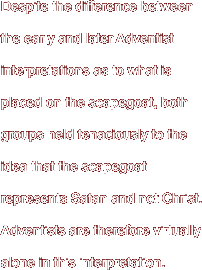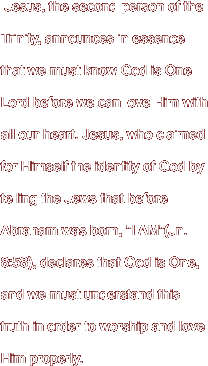 |
|
HOME | PROCLAMATION! MAGAZINE | DEVOTIONALS | STUDIES | LETTERS | ABOUT US | RELATED WEBSITES |
|
HOME / PROCLAMATION! MAGAZINE / 2010 / APRIL MAY JUNE / WHO IS YOUR SCAPEGOAT?
April May June 2010
VOLUME 11, ISSUE 2
A R T I C L E S

CHRIS BANDENHORST
Introduction
In ancient Israel, the scapegoat—along with the sacrifice—is at the heart of the Day of Atonement ritual. In Adventism, the defining sanctuary doctrine is based on its interpretation of Israel's sanctuary ritual; therefore, the scapegoat is likewise at the heart of Adventist theology. The sanctuary doctrine is unique to Adventism and constitutes the foundation of its faith (The Great Controversy, p. 409). It is also the only original contribution Adventism has made to Christian theology. Therefore, if this doctrine is wrong, then Adventism is wrong because if the foundation is unsound, the house built on that foundation is unsound (Matt. 7:24-27).
Early Adventism
The first Adventist to write out this doctrine of the sanctuary comprehensively was the pioneer O. R. L. Crosier. It was based on a re-interpretation of Daniel 8:14 (Adventism's cardinal text) after the Great Disappointment of October 22, 1844, and appeared in the Day Star Extra of February 7, 1846. Mrs. White, Adventism's prophetess, endorsed it with these words: "The Lord shew (sic) me in vision, more than one year ago, that Brother Crosier had the true light, on the Sanctuary, etc; and that it was his will, that Brother C. should write out the view which he gave us in the Day-Star, Extra, February 7, 1846. I feel fully authorized by the Lord, to recommend that Extra, to every saint." (Topsam, April 21, 1847). After her endorsement, the Adventist pioneers unanimously adopted the sanctuary doctrine as a tenet of Adventist belief.
In agreement with evangelical Christianity, Crosier showed from Leviticus 16 that it was the sins of God's people that were brought out of the sanctuary and placed upon the scapegoat. Then, however, he deviated from evangelicalism by taking the position that the scapegoat represented Satan and not Christ.
Satan-as-scapegoat was an entirely new concept to evangelicals. Crosier, though, could cite Jewish thought to substantiate his position thus: the Hebrew word for scapegoat is Azazel. Jewish scholars have stated that this term refers to some evil power, and therefore they interpret Azazel to represent the devil. Based on this Jewish understanding (instead of the teaching of Scripture, especially the New Testament) Crosier interpreted the scapegoat to be Satan. Ever since, Adventists have used this Jewish interpretation to validate their belief that the scapegoat is Satan.
The unique Adventist belief that the Sabbath is the seal of God and the sign that Adventists are God's end-time remnant has always provoked much criticism from other Christian bodies. The Adventist doctrine of the scapegoat being Satan, however, has generated the strongest derision. Very early, critics began denouncing Adventists as making Satan their sin-bearer and Savior.
The pioneers responded to these criticisms from non-Adventists by asserting that the scapegoat had no part in the sanctuary service until after God's people were saved and sealed. This explanation, however, was not convincing to the evangelicals, so the criticism continued.
Uriah Smith responded by explaining the jurisprudence of both Christ and Satan suffering on account of the sins of the righteous, but he used arguments that were not sound. A. F. Ballenger, who later left the ranks of Adventism, seized upon the weakness of Smith's argument and deviated from the original position, arguing that the sins of the righteous are not placed on Satan at all; he only bears his part in causing them to sin.
Later Adventism
Because of the continued criticism by the evangelicals, later Adventist writers and teachers adopted a compromised Ballenger position. One of these was M. L. Andreasen, a prominent theologian and teacher. Although he was loyal to Adventist doctrines overall, he did come to accept Ballenger's re-interpretation that it is Satan's part in causing the righteous to sin that is placed on the scapegoat. In addition, he and his contemporaries also included the wicked in the scapegoat transaction saying that Satan bears the blame for the sins which he caused both the righteous and the wicked to commit. They, however, unanimously denied that the sins of the righteous are placed on Satan.
Thus, in original Adventism, the scapegoat (Satan) bore away the sins of the righteous while the wicked suffered for their own sins in the lake of fire. Some of the early Adventist authors who adopted this teaching developed by Crosier are Mrs. White, Smith, Johnson, Gilbert and Haskel.
The later Adventist teaching is that the scapegoat (Satan) does not bear in any way or degree the guilt and responsibility for the sins of the righteous. He only bears these for his part in the sins of all mankind, both the righteous and wicked. Some of the later Adventists who adopted this deviation from the historic teaching of EGW and the pioneers are Andreasen, Watson, Branson, Hardinge, Kern, Reed and the writers of Questions on Doctrine (QD).
Despite the difference between the early and later Adventist interpretations as to what is placed on the scapegoat, both groups held tenaciously to the idea that the scapegoat represents Satan and not Christ. Adventists are therefore virtually alone in this interpretation.
The Scapegoat Transaction: Leviticus 16
Concerning the scapegoat transaction, the Levitical record states:
"From the Israelite community he [Aaron] is to take two male goats for a sin offering and a ram for a burnt offering…Then he is to take the two goats and present them before the LORD at the entrance to the Tent of Meeting. He is to cast lots for the two goats—one lot for the LORD and the other for the scapegoat. Aaron shall bring the goat whose lot falls to the LORD and sacrifice it for a sin offering. But the goat chosen by lot as the scapegoat shall be presented alive before the LORD to be used for making atonement by sending it into the desert as a scapegoat…When Aaron has finished making atonement for the Most Holy Place, the Tent of Meeting and the altar, he shall bring forward the live goat. He is to lay both hands on the head of the live goat and confess over it all the wickedness and rebellion of the Israelites—all their sins—and put them on the goat's head. He shall send the goat away into the desert in the care of a man appointed for the task. The goat will carry on itself all their sins to a solitary place; and the man shall release it in the desert" (Lev. 16:5, 7-10, 20-22).
From this Scripture it is clear that:
- The sins that are brought out of the sanctuary on the Day of Atonement are placed on the scapegoat.
- The sins that are brought out of the sanctuary on the Day of Atonement are those of penitent Israel—the people of God.
- Therefore, it is these sins—the sins of penitent Israel (the people of God) that are placed on the scapegoat.
- The purpose of this transaction is "to make an atonement with him" (Lev. 16:10 KJV).
Mrs. Ellen G. White (EGW)
As regards the original Adventist concept concerning the scapegoat, EGW could hardly be more definite upon this matter. She states it as follows:
As in the final atonement the sins of the truly penitent are to be blotted from the records of heaven, no more to be remembered or come into mind, so in the type they were borne away into the wilderness, forever separated from the congregation.
Since Satan is the originator of sin, the direct instigator of all the sins that caused the death of the Son of God, justice demands that Satan shall suffer the final punishment. Christ's work for the redemption of men and the purification of the universe from sin, will be closed by the removal of sin from the heavenly sanctuary and the placing of these sins upon Satan, who will bear the final penalty (Patriarchs and Prophets, p. 358).
When the ministration in the holy of holies had been completed, and the sins of Israel had been removed from the sanctuary by virtue of the blood of the sin-offering, then the scapegoat was presented alive before the Lord; and in presence of the congregation the high priest confessed over him ‘all the iniquities of the children of Israel, and all their transgressions in all their sins, putting them on the head of the goat' (Lev. 16:21). In like manner, when the work of atonement in the heavenly sanctuary has been completed, then in the presence of God and heavenly angels, and the host of the redeemed, the sins of God's people will be placed upon Satan; he will be declared guilty of all the evil he has caused them to commit. And as the scapegoat was sent away into a land not inhabited, so Satan will be banished to a desolate earth, an uninhabited and dreary wilderness (The Great Controversy p. 658).
In the typical service the high priest, having made the atonement for Israel, came forth and blessed the congregation. So Christ, at the close of His work as mediator, will appear, "without sin unto salvation" (Heb. 9:28), to bless His waiting people with eternal life. As the priest, in removing the sins from the sanctuary, confessed them upon the head of the scapegoat, so Christ will place all these sins upon Satan, the originator and instigator of sin. The scapegoat, bearing the sins of Israel, was sent away "unto a land not inhabited" (Lev. 16:22); so Satan, bearing the guilt of all the sins which he has caused God's people to commit, will be for a thousand years confined to the earth, which will then be desolate, without inhabitant, and he will at last suffer the full penalty of sin in the fires that shall destroy all the wicked (ibid., pp. 485-486).
The wicked receive their recompense in the earth (Prov. 11:31). They "shall be as stubble: and the day that cometh shall burn them up, saith the Lord of hosts" (Mal. 4:1). Some are destroyed as in a moment, while others suffer many days. All are punished "according to their deeds." The sins of the righteous having been transferred to Satan, he is made to suffer not only for his own rebellion, but for all the sins which he has caused God's people to commit (ibid., p. 673).
If after reading the above statements some have any doubt left in their minds as to what EGW means, they should have none after reading the following statement:
Satan did not then exult as he had done. He had hoped to break up the plan of salvation; but it was laid too deep. And now by the death of Christ he knew that he himself must finally die, and his kingdom given to Jesus. He held a council with his angels. He had prevailed nothing against the Son of God, and now they must increase their efforts and with their powers and cunning turn to His followers. They must prevent all whom they could from receiving the salvation purchased for them by Jesus. By so doing Satan could still work against the government of God. Also it would be for his own interest to keep from Jesus as many as possible. For the sins of those who are redeemed by the blood of Christ will at last be rolled back upon the originator of sin, and he must bear their punishment, while those who do not accept salvation through Jesus will suffer the penalty of their own sins (Early Writings p. 178).
Adventism's Dilemma
Many later Adventist theologians have been embarrassed by these statements of EGW, especially the one in Early Writings. Some who were personally acquainted with Andreasen stated that he admitted he was at a total loss to explain the statement of EGW in Early Writings. So, in order to alleviate their embarrassment, he and others after him pursued Ballenger's deviation from the historic concept that Satan will bear the actual sins of the righteous.
The writers of Questions on Doctrine (QD) joined the ranks of those who deviated from the original teaching by setting forth the view that Satan does not bear the sins of the righteous "in any sense or degree" (QD p. 400). It says that Satan bears the responsibility "for his part in all the sins he has caused others, both righteous and wicked to commit" (QD p. 397), and attempts to show that bearing this responsibility is the meaning and significance of the scapegoat transaction. This interpretation, however, is a blatant contradiction of what EGW and the pioneers taught. It is interesting to note that QD, which quoted liberally from EGW in most sections, did not cite one reference when it came to the scapegoat!
Moreover, the Levitical record, EGW, and the pioneers all taught that it was the sins of penitent Israel that were brought out of the sanctuary and placed upon the scapegoat. The high priest did not remove any sin of Satan's from the sanctuary. So how could Adventists say that Christ removes Satan's sin from the heavenly sanctuary and places it on his own head at the end of the Investigative Judgment? This is just so much nonsense. The scapegoat transaction has nothing to do with putting Satan's part in causing others to sin upon his head! These sins are already upon his head. Furthermore, it is also entirely erroneous to involve "both righteous and wicked" (QD p. 397, 399, 400) in the scapegoat transaction. The wicked are not included in this transaction at all; they "will suffer the penalty of their own sins" (Early Writings, p. 178).
Embarrassment and Compromise
When I left Adventism in 1980, this scapegoat transaction was still the most embarrassing doctrine in modern Adventist teaching. Most were at a loss to explain to evangelical Christians why, according to EGW, Satan has to suffer for the sins of the righteous when the Bible is clear that Jesus has already suffered for them on the cross (Heb. 2:9). Also, the Bible says that not only are "the wickedness and rebellion of Israelites" (Leviticus 16:21) put on the head of the scapegoat, but also that these sins are put on him "for making atonement with it" (verse 10). Why would EGW say Satan makes an atonement for the sins of the righteous in the end when Jesus has already made an atonement for them on the cross (1 Jn. 2:2)?
Modern Adventist teachers and scholars, being at a loss to explain EGW's teaching—even being terrified of this problem, have tried to escape it by flatly denying Satan ultimately bears the sins of the righteous. This denial, however, leads to a greater problem, for those who deny the teaching that the sins of the righteous are placed on Satan must deny EGW. Once EGW is denied as unreliable in one important area of Adventism's cardinal sanctuary teaching, can she be relied upon in other areas of its teaching? Who draws the line and where?
The Implications
The implications of Adventism's Satan-as-scapegoat theology are grave: Christ did not make the atonement for man's sins when He shed His blood upon the cross. He was only the Sacrifice. Referring to the Day of Atonement service in ancient Israel, EGW states: "…the sin offering pointed to Christ as a sacrifice…(Great Controversy p. 422, 489). Referring to Christ's death on the cross, she states: "Christ's sacrifice in behalf of man was full and complete. The condition of the atonement had been fulfilled" (Acts of the Apostles, p. 29).
In other words, EGW taught that the sacrifice of Christ on the cross was full and complete, but it was not the atonement; it was merely the condition of the atonement—an atonement that He would subsequently make in heaven after His ascension. Therefore, in Adventist theology sacrifice and atonement are not synonymous as they are in Christian theology because Adventism bases its theology on the shadow of ancient Israel's Day of Atonement where the sacrifice was slain outside the sanctuary and the atonement was made inside the sanctuary.
EGW therefore teaches that on the cross Christ was the Sacrifice providing the blood for two atonements that He would subsequently make in the heavenly sanctuary. The first, which is ‘preliminary', transfers the guilt from penitent sinners to Himself in the sanctuary. The second, which is ‘final', blots out the records of believers' sins and transfers their guilt from Jesus (and thus from the sanctuary) onto Satan who then pays "the full penalty of sin" (Great Controversy p. 485). In other words, traditional Adventism teaches that Christ does not pay the penalty for sin. Rather, the cross qualified Him to bear confessed sins in the heavenly sanctuary temporarily until they are ultimately transferred onto Satan who will finally pay their penalty in full.
Yes, EGW does also say that Christ made a full atonement on the cross in some of her books like Desire of Ages, which she largely copied from the evangelical author Edersheim. This confusion, which is typical of her legacy to Adventists, is the result of her spiritual inability to discern the fundamental difference between Adventism's original sanctuary doctrine and the doctrine of the atonement taught in the evangelical books she was secretly copying under so-called "inspiration" or "inspired plagiarism".
Evangelical Christianity
Evangelical Christianity also states that the scapegoat pays the penalty for the believer's sins—but Christianity rightly identifies the scapegoat as Christ, not Satan. It is Jesus, not Satan, who took our sins upon Himself on the cross, who was declared guilty in our place, who paid the penalty in full, and who bore our sins away "into the desert…to a solitary place" (Lev. 16:21, 22)—a land of no return, forever separated from the believer. "As far as the east is from the west, so far has he (God) removed our transgressions from us" (Ps. 103:12).
To be sure, Azazel, which means "goat of removal," represented something evil in the same way the brass serpent that Moses put on a pole in the wilderness represented the deadly evil of the snakes that were killing the Israelites. Yet Jesus identified Himself with that serpent (Jn. 3:14, 15) as the One who would give eternal life to all who would look to Him in faith just like the dying Israelites were saved from death by looking up at the serpent on the pole (Num. 21:4-9).
How could two evil things like Azazel and the serpent represent the pure and sinless Son of God? Because, according to the Scriptures, "He himself bore our sins in his body on the tree" (1 Pet. 2:22-24)! And because Christ "bore the sins of many" (Is. 53:12), He became "a curse for us" (Gal. 3:13); He "who had no sin was made to be sin for us" (2 Cor. 5:21). Jesus is not only the antitypical serpent on the pole who gives life to the spiritually dead, but He is also the antitypical Azazel "who takes away the sin of the world" (Jn. 1:29).
The Ultimate Question and Answer
The ultimate question we must answer is this, "Who, according to the Bible, does the scapegoat represent?" The answer must come straight from Scripture; otherwise we will be guilty of going beyond what is written in Scriptue. (See 1 Cor. 4:6).
We all, like sheep, have gone astray, each of us has turned to his own way; and the LORD has laid on him (Christ) the iniquity of us all (Is. 53:6).
After the suffering of his soul, he will see the light of life and be satisfied; by knowledge of him my righteous servant will justify many, and he (Christ) will bear their iniquities…he poured out his life unto death, and was numbered with the transgressors. For he (Christ) bore the sins of many, and made intercession for the transgressors (Is. 53:11, 12).
"He (Christ) committed no sin, and no deceit was found in his mouth. When they hurled their insults at him, he did not retaliate; when he suffered, he made no threats. Instead, he entrusted himself to him who judges justly. He himself bore our sins in his body on the tree, so that we might die to sins and live for righteousness" (1 Pet. 2:22-24).
In Revelation 20:7-10 Satan's doom is described, but it says nothing about the sins of the righteous being put on his head.
When the thousand years are over, Satan will be released from his prison and will go out to deceive the nations in the four corners of the earth—Gog and Magog—to gather them for battle. In number they are like the sand on the seashore. They marched across the breadth of the earth and surrounded the camp of God's people, the city he loves. But fire came down from heaven and devoured them. And the devil, who deceived them, was thrown into the lake of burning sulfur, where the beast and the false prophet had been thrown. They will be tormented day and night for ever and ever.
Nowhere does the Bible say that the sins of the righteous are ultimately transferred to Satan for the payment of their penalty. The only source of this idea is the extra-biblical writings of EGW.
Furthermore, Leviticus 16:5 states: "From the Israelite community he (Aaron) is to take two male goats for a sin offering and a ram for a burnt offering." Was Satan created by God to be a sin offering for us? Hebrews 10:12 states: "But when this priest (Jesus) had offered for all time one sacrifice for sins he sat down at the right hand of God." Jesus, not Satan, was to be the sin offering.
Leviticus 16:10 states: "But the goat chosen by lot as the scapegoat shall be presented alive before the LORD to be used for making atonement by sending it into the desert as a scapegoat." Was Satan created by God to make atonement for our sins? 1 John 2:2 states that "He (Jesus) is the atoning sacrifice for our sins, and not only for ours but also for the sins of the whole world."
A Third Party
Jesus' payment for our sins on the cross means that God Himself had to redeem the full penalty (debt) that He levied against man for his sins. God could not ask a third party in His kingdom to pay man's penalty no matter how willing that party may have been to do so. In other words, even if the angel Gabriel offered to pay man's penalty, God would not have allowed him to because such a substitution would have been immoral and unjust.
From the standpoint of divine justice, either guilty man himself pays his own debt with his own life, or God Himself, against whom man has sinned and with whom man is in debt with his life, pays on man's behalf.
Praise God! Because of His infinite love for man, God Himself paid our debt in the person of Christ. Satan, a third party, could never be the scapegoat on whom our sins are laid for payment. No, God the Son—the Lord Jesus Christ—took upon Himself mortal humanity in His incarnation so He could give it up in death on behalf of guilty man. Thus was He called "‘Immanuel,' which means ‘God with us'" (Matt. 1:23)—with us in human form. This forever disqualifies Satan—a third party—from being the scapegoat.
Finally, a concordance word check shows that nowhere in the entire Bible is a goat ever used to represent Satan as the scapegoat. The goat is always used as a sin offering or for making atonement. Satan, bearing the guilt of the redeemed according to Adventism and its prophetess, is not in any way a sin offering or a form of atonement. According to the Bible, only one Person was qualified for this role—the Lord Jesus Christ our Savior who shed His precious blood upon the cross for our sins.
It is clear that EGW and the Bible are in conflict concerning this doctrine of the scapegoat as they are in so many other areas. We cannot have both. You, the reader, must decide which of the two interpretations will be the basis of your faith. †
![]()
Copyright 2010 Life Assurance Ministries, Inc., Glendale, Arizona, USA. All rights reserved. Revised July 13, 2010. Contact email: proclamation@gmail.com




Chris Badenhorst, a former Seventh-day Adventist, is a retired civil engineering technician who still works part time on one of South Africa's oil refineries in the city of Durban on the east coast. He is married with three step-children and one grandchild. His wife is also a former Adventist who shares his enthusiasm for the gospel of God's grace. Although they are not members of a particular denomination, they attend a local Baptist church for worship and fellowship.
